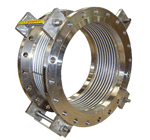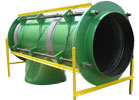| Type |
Design |
Description |
Types of Movement |
Principal Advantages and Limitations |
Principal Uses |
| Single |
 |
A single pipe expansion joint is simply a bellows element with end connections. |
- Absorbs small amounts of lateral, axial, and angular movements
- Deflects in any direction |
- Usually provides the most economical pipe expansion joint design
- Readily applicable to long and straight piping runs
- Simplest construction and minimum delivery time
- When Internal Guide is installed, it insures proper initial alignment of pipe expansion joint |
- Absorbs thermal expansion or contraction of piping systems and equipment where proper guiding and anchoring is feasible
- Isolates high frequency and low amplitude equipment vibrations from piping and duct systems
- Seals piping penetrating bulkheads, containment vessels, etc.
- Minimizes thermal loading on machinery and vessels |
| Universal |
 |
The universal pipe expansion joint consists of two bellows separated by a pipe section or spool. |
- Axial movement
- Large amounts of lateral deflection is a function of the amount of angulation each bellows can absorb and the distance between the bellows
-Angular rotation |
- Usually the most economical tied unit
- Can be displaced laterally in any direction
- With overall tie rods, it absorbs all growth of piping within pipe expansion joint
- Tie rods can be designed to restrict and control motion, support weight
- Can absorb external axial movement if it is not essential to function as a tied unit
- Requires 90° change in piping direction if it is required to function as a tied unit |
- Absorbs large lateral movements while tied to restrict pressure thrust
- Requires only light anchors and minimum guiding |
| Elbow Pressure Balanced |
 |
Elbow pressure balanced pipe expansion joints are a combination of several types. |
- Axial movement
- All lateral deflection is absorbed by the universal end
- Angular rotation |
- Only tied-type pipe expansion joints are able to absorb axial movement external to the tie rods while still restraining pressure thrust
- Requires change in piping direction |
- Absorbs axial or combined/lateral movement where pressure thrust on equipment or anchors cannot be tolerated |
| Inline Pressure Balanced |
 |
Inline pressure balanced pipe expansion joint is similar to the presure balanced elbow type, in that the axial pressure thrust is reacted by the pressure acting on a cross-sectional area equal to the area of the working or primary bellows. |
- Axial movement
-Lateral deflection |
- Only tied-type pipe expansion joint able to absorb axial movement external to joint while still restraining pressure thrust |
- Absorbs axial or combined/lateral movement where pressure thrust on equipment or anchors cannot be tolerated |
| Hinged |
 |
Hinged pipe expansion joints contains hinges or pivots which allow the unit to bend in a single plane. |
- Angular rotation in a single plane |
- Provides for close control of movement
- Hinges can carry dead weight of piping and other external loads
- Transmits shear loads
- Prevents torsion on bellows
- Minimum guide and anchor requirements |
- Used in pairs or sets of three to absorb large complex single plane motions without imposing pressure thrust on pipe or equipment
- Transmits weight and other loads to available support points in "open" areas |
| Gimbal |
 |
The gimbal pipe expansion joint is basically the same as the hinge pipe expansion joint, except it can accept angulation in any two planes. |
- Angular rotation in any plane |
- Provides for close control of movement
- Gimbals can carry dead weight of piping and other external loads
- Transmits shear loads
- Prevents torsion on bellows
- Minimum guide and anchor requirements |
- Used in pairs or a set of two gimbal and one hinged type pipe expansion joint to absorb large, complex, multi-plane motion without imposing pressure thrust on piping or equipment
- Same use as hinged pipe expansion joint but in multi-plane applications |
| Externally Pressurized |
 |
Externally pressurized pipe expansion joints, also known as x-flex expansion joints, are suited for piping systems that require large amounts of axial compression or extension. |
- Axial compression or extension |
- Eliminates pressure instability as a limitation to the design and permits the absorption of large amounts of axial expansion |
- Steam lines
- Large axial movements |
| Toroidal |
 |
A toroidal pipe expansion joint may consist of one or multiple convolutions |
- Axial stroke |
- Pressure resistance is high
- Due to the toroidal shape, deflection is limited.
- With "U" shaped convolutions, more deflection can be achieved but allowable pressures are lower |
- High pressure applications where little movement is required |
| Thick-Wall |
 |
Thick-wall pipe expansion joints are used primarily in heat exchangers and large diameter piping systems where thin-wall pipe expansion joints would not be sufficient. |
- Axial movement only |
- The distribution of axial, angular, and lateral forces will be different when thick-wall pipe expansion joints are used |
- Primarily used in heat exchangers and large diameter piping systems where thin-wall pipe expansion joints would not be sufficient |
| Slip-Type |
 |
Slip type pipe expansion joints are used when the primary problem is a large axial movement. |
- Axial movement |
- Some applications may require plated surfaces to minimize abrasive wear
- Special features such as "wipers" can be included to prevent potential clogging of the clearances provided for slip movement |
- Steam lines |
| Rectangular |
 |
Each rectangular metal pipe expansion joint is custom-engineered to provide the most economical design that will absorb the thermal movements of the system in which it is installed. |
- Axial movement
- Lateral movement
- Angular movement
|
- It is critical to know which direction the lateral and angular movements will occur( i.e. parallel to the long and/or short side of the bellows) in order to design the rectangular bellows properly |
- Absorbs thermal movements in duct work |